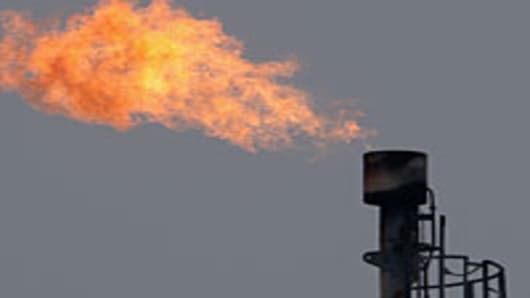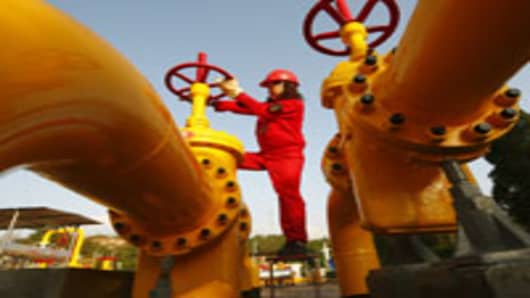In just a few years the U.S. natural gas industry has seen an epic boom in production. Though prices have plunged, volatility is a fraction of what it has been in the past.
The kicker is that this boom came not from a Manhattan Project-styled government initiative, but from private industry's development of ground-breaking fracking technology to tap previously unreachable gas reserves in shale formations.
But should it stay this way? After all, other countries have invested billions in alternative fuels, from Brazil's government-sponsored ethanol push to France's headlong expansion of nuclear power after the oil shocks of the 1970s. Should the U.S. do the same?
The answer, from a wide range of experts, whether the Heritage Foundation or the Natural Resources Defense Council, surprisingly enough is no.
In short, support for a domestic, industrial pro-gas policy is hard to find, and what there is, is tepid. In fact, industry, energy, and public policy experts say that not only has natural gas thrived without a massive government push, but such support could prove counter-productive.
“I think natural gas is doing really well right now, and prices have dropped a lot because of new supply,” says Dina Kruger, head of Kruger Environmental Strategies and former director of the climate change division at the Environmental Protection Agency. “It’s hard to see the price volatility people had been concerned about in the 1990s and the first part of the 21st century. Natural gas is in a pretty good position, and has been competing effectively in the framework we have.”
Even if there was some political will, Kruger says that in an era of big federal deficits and the near-term prospect of a fiscal cliff, it’s hard to envision a scenario in which the government would work to make an already cheap, abundant, energy supply even more so.
After all, prices have been bouncing at record lowsand are now a quarter of what they were at their 2008 peak.
No one knows how much gas there is in the U.S., but experts say the amount recoverable —thanks to hydraulic fracturing or “fracking,” among other technologies — is staggering. Some say 100 years on an existing use basis; other less.
“Shale gas reserves are so large that on the basis of what we know today, we have 50-75 years of gas available at current production levels, and probably higher,” says Charles Ebinger, director of the energy security initiative at the Brookings Institution.
Tax Credits and Subsidies
Ebinger, however, is wary of trying to support the boom through tax credits for gas producers and the like, fearing such maneuvers could lead to unintended consequences.
He does say one area where natural gas drillers benefit from government intervention is in the form of the ability to write the depreciation on capital investments at an accelerated rate.
This puts cash in drillers’ hands sooner, allowing quicker funding for more wells. Such benefits could be important, but he is not sure how important.
"If you abolish those accelerated write-offs they will probably drill less wells," he said. "Whether that would have a dramatic impact on supply or not is not easy to calculate."
Dan Lashof, director of the climate change and clean air program at the Natural Resources Defense Council, is also against a pro-gas push.
“Federal policy should be fuel neutral,” he says. “The policy we need to focus on is to ensure that amidst the rush to produce natural gas, that we minimize the adverse environmental consequences of that rush.”
Nick Loris, energy policy analyst with the Heritage Foundation, also opposes subsidies.
“We should allow the market to work,” he says. “We can create an energy boom, and jobs around the country, if it makes economic sense to develop it.” As for regulation, Loris believes this should be done at the state level, as they best understand their terrain.
Pipeline Push
As the natural gas boom continues, it is almost certain that this will engender at least hundreds of miles of new pipeline, says Ebinger.
The Brookings Institution found that in 2010, fewer than half the 1,100 wells drilled in theMarcellus Shale Reserve— which covers the states of New York, Ohio, Pennsylvania and West Virginia and is one of the nation's largest — had access to pipelines.
ICF International, a multi-industry consultancy, determined that 3,300 miles of transmission pipeline will be built in North America between 2009 and 2035.
What controversy there is, says Loris, comes mainly in the Northeast, where old infrastructure must be torn up in order to lay new pipelines, and environmental opposition is high.
As such, he believes it will likely prove far easier to simply lay new pipelines in the less dense areas of the U.S., such as the West.
New pipelines also can have an environmental benefit because gas that can’t be captured on site is often “flared,” a process that is both wasteful and potentially toxic.
The natural gas boom also has a powerful political component.
For decades, leaders in both government and industry have bemoaned America's dependence on imported crude oiland how it undercuts national security.
Though more than a few proponents of natural gas have called it a means to energy independence, experts interviewed for this story say gas actually has a minor role in the national security debate.
The Natural Resources Defense Council's Lashof sees natural gas as a potential stabilizing force, a hedge against oil. “It is produced domestically, versus oil, and oil distorts our foreign policy,” he says.
Brookings' Ebinger sees U.S. domestic natural gas, in the form of transportable liquefied natural gas, as a potential alternative to what he considers the cartel-like pricing dictated by Russia’s Gazprom, which dominates Europe’s gas market. Such export capacity would make it easier to attract and sustain allies.
Presidential Issue?
Though energy has yet to emerge as a major issue in the 2012 presidential race between President Barack Obama and Mitt Romney, Obama has already staked outa pro-gas positionwith the requisite nod to the economy.
Analysts say this has two benefits. One is that natural gas is produced in many swing states, including Pennsylvania. Another is that his support for the fuel gives him a counter-argument to those who say he is anti-growth and anti-business, having blocked the Keystone oil pipeline in January.
The Obama administration recently approved the drilling of 3,676 natural gas wells in Utah; and requests by environmentalists to ban diesel in fracking have fallen on deaf ears. As importantly, the president has also convened a working group to include both industry execs and government regulatory agencies to coordinate domestic natural gas production.
At the same time, it’s hard to imagine an all-out push from the White House, as the Obama administration remains torn behind efforts to endorse natural gas, still a fossil fuel, and support for sustainable, renewable alternative fuels, say experts.
Not to mention the administration might still feel the burn from its controversial financial support of the solar firm Solyndra, which went bankrupt.
Romney, though generally very supportive of the traditional energy industry, has yet to fully articulate a policy. His campaign website simply says he wants to "prevent over-regulation of shale gas development and extraction."
Ebinger says still more can and should be done at the presidential level, by both candidates, to raise awareness about natural gas.
“If I were a presidential candidate I would say to the American people this resource is big enough where it could lead to a revitalization of American industry.”



